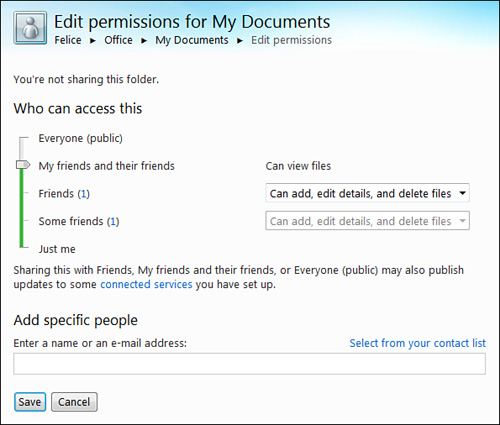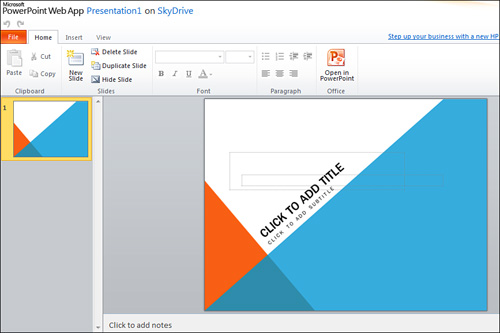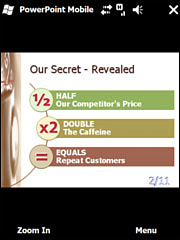Setting SkyDrive Permissions
If you want others to view or
edit your SkyDrive files, you must give them permission. In SkyDrive,
you set permissions at the folder level, not for each individual file.
Setting Permissions
To set permissions, follow these steps:
1. | In the SkyDrive main window (refer to Figure 2), select the folder for which you want to set permissions.
|
2. | From the Share drop-down list, select Edit Permissions.
|
3. | Select the group of people you want to share with, as shown in Figure 6.
Optionally, you can also enter the e-mail address of an individual you
want to share with and specify permissions for this person.

|
4. | From the drop-down list that displays, select one of the following options, depending on the permissions you want to set:
- Can View Files
- Can Add, Edit Details, or Delete Files
|
5. | Click the Save button to save your permission settings.
|
Editing Presentations in the PowerPoint Web App
You can edit any
presentation that you create or save in SkyDrive. If one of your
colleagues saves a presentation to SkyDrive, your ability to edit
depends on the permissions this person gives you.
Editing a Presentation in the PowerPoint Web App
To edit a presentation, follow these steps:
1. | In SkyDrive, select the folder that contains your presentation.
|
2. | Select the presentation you want to edit. If you haven’t activated the Web App, you’re prompted to do so.
|
3. | Click the Edit in Browser button (see Figure 7) to open the presentation in the Microsoft PowerPoint Web App. Remember, you must have edit rights for this link to display.

|
|
From each individual file’s
page on SkyDrive, you can also add comments, select people to share your
presentation with, and download, delete, copy, or rename your
presentation.
|
Figure 8 shows the PowerPoint Web App in Edit mode.

This mode includes the following tabs:
File—
Display a menu of choices that enables you to open your presentation
directly in the desktop version of PowerPoint, provide feedback to
Microsoft, or close your presentation.
Home—
Cut, copy, and paste objects; create, delete, duplicate, and hide
slides; modify and format text; and open your presentation in
PowerPoint.
Insert— Insert pictures, SmartArt graphics, or hyperlinks.
View— Choose to view your presentation in one of the following views: Editing, Reading, Slide Show, or Notes.
The commands and buttons on
these tabs function in much the same way as they do in the desktop
version of PowerPoint. The main difference is that you can perform them
online on a computer that doesn’t have PowerPoint installed.
|
The PowerPoint Web App doesn’t have a Save button because it saves your changes automatically.
|
Viewing Presentations in the PowerPoint Web App
Even if you don’t have edit rights to a presentation, you can still view it if the owner gives you view privileges.
Viewing a Presentation in the PowerPoint Web App
To view a presentation, follow these steps:
1. | In SkyDrive, select the folder that contains your presentation.
|
2. | Select the presentation you want to view.
|
3. | Click the View link to open the presentation in the PowerPoint Web App.
|
Figure 9 shows the PowerPoint Web App in View mode.

This mode includes the File
tab, which offers a menu of choices that enables you to open your
presentation directly in the desktop version of PowerPoint, provide
feedback to Microsoft, or close your presentation.
You can also click one of the following buttons:
- Open in PowerPoint
- Edit in Browser (if you also have edit rights)
- Start Slide Show
Accessing PowerPoint from Mobile Devices
If you want to access your PowerPoint presentations on the go, consider Microsoft PowerPoint Mobile 2010 (http://www.microsoft.com/office/2010/en/mobile/default.aspx).
The PowerPoint mobile application isn’t part of the standard Microsoft
Office 2010 suite but is a separate application available for Windows
smartphones running Windows Mobile 6.5 or above. Microsoft Office Mobile
2010 also includes SharePoint Workspace Mobile and mobile versions of
Word, Excel, and OneNote. A mobile Outlook application comes
preinstalled on these phones.
With PowerPoint Mobile, which is shown in Figure 10, you can
View and edit your presentations, including charts, tables, and SmartArt graphics.
Share
your presentation files with others via email or SharePoint Server 2010
(using the SharePoint Workspace Mobile application).
Copy and paste content from within PowerPoint or other applications.
Control
a PowerPoint presentation on your laptop computer from your Windows
phone using the Presentation Companion. You can download Presentation
Companion from the Microsoft Download Center at http://www.microsoft.com/downloads.
An advantage of using the Presentation Companion is that it gives you
the ability to use multiple monitors—one for delivering your
presentation and another (your phone) for viewing your speaker’s notes.
